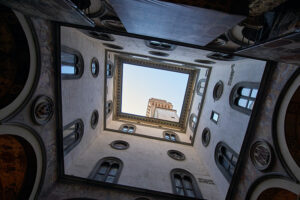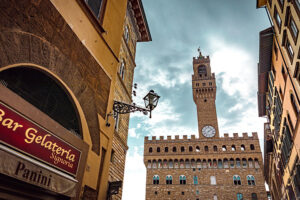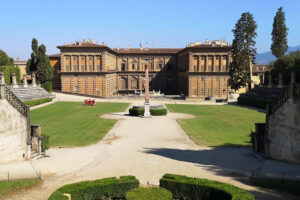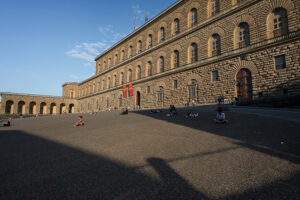Visiting the Pitti Palace
The grandiose, impressive, huge Pitti Palace is no doubt among Florence’s main attractions. And rightfully so, seeing as it housed three noble dynasties, the Medici Grand Dukes, the House of Habsburg-Lorraine, and then finally the Kings of Italy (House of Savoy), and today hosts five incredible museums.
Is a visit to the Pitti Palace worth it?
If you’re in Florence, a visit to Pitti Palace is absolutely worth it. Whether you’re into Renaissance art, history, modern art, jewelry, precious stones, or even fashion and style, you’ll find what you’re looking for in its two, gloriously decorated and marvelously furnished floors.
One palace, five museums
Today, the massive, stately palace commissioned by banker Luca Pitti and then bought by Eleonora di Toledo (wife of the banker’s archenemy Cosimo I de’ Medici) hosts five extraordinary museums. These are:
- The Treasury of the Grand Dukes and Museum of Russian Icons (with the Palatine Chapel)
- The Palatine Gallery
- The Imperial and Royal Apartments
- The Gallery of Modern Art
- The Museum of Costume and Fashion
My suggestions for an enjoyable visit
Just like the Uffizi Gallery, the Pitti Palace is too big, and houses too many masterpieces, to be seen all in one go. I strongly suggest you choose what collection you wish to see, and focus on that. Then, perhaps, come back another day and see another part of it. For instance, see the Palatine Gallery on one day and the gallery of Modern Art on another.
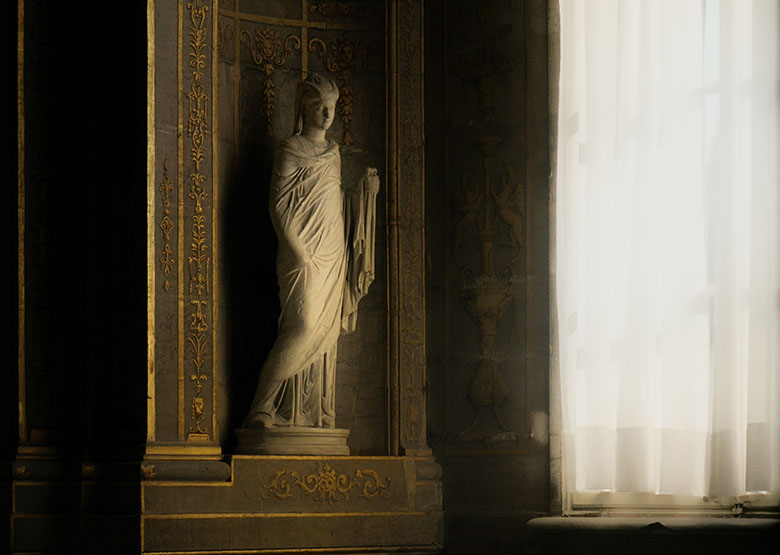
The Treasury of the Grand Dukes, Museum of Russian Icons, and Palatine Chapel
The Treasury of the Grand Dukes is housed on the ground and mezzanine floors of the palace and comprises the collections once included in the former Silver Museum. Visiting this part of the Pitti Palace is really exciting because it’s where the Medici Grand Dukes used to live, and the astonishing Medici treasure is on display. You’ll get to see crystals, vases, amber and ivory objects, the stunning silver brought by Ferdinand III of Habsburg-Lorraine, jewelry collections dating back to the 17th and 20th, and contemporary jewelry. The Museum of Russian Icons houses an ancient and stunning collection of Russian icons. It’s located on the ground floor of the palace, right by the beautiful Palatine Chapel, once the central room of the Grand Ducal apartments, renovated, redecorated, and turned into a chapel in 1766, by Ferdinand III Grand Duke of Tuscany.
The Palatine Gallery
The Palatine Gallery was created by the Habsburg-Lorraine Grand Dukes between the end of the 18th century and the beginning of the 19th century and comprises the most important masterpieces from the Medici collections. Aside from incredible paintings, including works by Titian, Tintoretto, and Caravaggio, you’ll be able to see breathtaking sculptures, sumptuous frames, inlaid-stone tables, and opulent furniture. Don’t miss Pietro Da Cortona’s frescoes in the Planet Rooms, they’re incredible!
The Imperial and Royal Apartments
Another thrilling area of the palace to visit for a journey back in time. The Medici Princes, then the Grand Dukes of Habsburg-Lorraine, and finally the members of Italy’s royal family lived in these extraordinarily furnished rooms, and you can appreciate each era’s distinctive taste and style through the gilt mirrors, tapestry, and furnishings.
The Gallery of Modern Art
Housed on the Pitti Palace’s second floor, the Gallery of Modern Art offers magnificent views of the Boboli Gardens, alongside a remarkable collection of sculptures and paintings created between the 18th century and the early 20th century. Highlights include works of the Macchiaioli school, with several masterpieces by Giovanni Fattori, and of the Divisionist and Symbolist movements. Among the artists exhibited are Lega, Hayez, Signorini, Pissarro, and many others.
The Museum of Costume and Fashion
A mesmerizing, continuously rotating, collection of clothes, accessories, and jewels dating as far back as the 16th century (the restored attire that belonged to Cosimo I de’ Medici, Eleanora di Toledo, and their son Garzia de’ Medici), wondrous pieces from the 18th, 19th and 20th centuries, plus amazing costumes that were worn by actors and actresses in movies and on the stage.
Pitti Palace hours
The Pitti Palace museums are open from Tuesday to Sunday, from 8.15 AM to 6.30 PM. All the Pitti Palace museums are closed on Mondays, January 1, and Christmas Day (December 25).
Tickets for Pitti Palace
You can easily buy Pitti Palace tickets, and even combined Pitti Palace and Boboli Gardens tickets both at the ticket office at the Pitti Palace and online, on the official website.
Current fees are:
Single ticket for all the Pitti Palace collections €10 per person
Combined Pitti Palace and Boboli Gardens tickets €14 per person
The Porcelain Museum in Florence: where it is
Seeing as you can buy a combined Pitti Palace and Boboli Gardens ticket, once at the Pitti Palace you might want to take a stroll in the wonderful Boboli Gardens and walk up to the Palazzina del Cavaliere, the Knight’s Building and Rampart, where the Porcelain Museum in Florence is housed. This charming museum rises in a striking position up at the top of the monumental park and has a fascinating history.
The Porcelain Museum in Florence: facts and useful information
A knight called Malatesta Baglioni used to live here originally, and later Cosimo III de’ Medici had the building we admire today built for his son Giangastone. Inside the former knight’s home, you’ll find the Porcelain Museum, an exceptionally fine selection of superb Ginori, Sèvres, and Meissen porcelain pieces from the Habsburg-Lorraine collection. This museum is part of the Boboli Gardens so opening hours and tickets are included in Boboli Gardens tickets.


